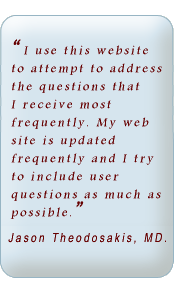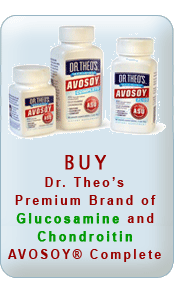Q & A
Arthritis Q & A
Book Q & A
Supplements Q & A
Home Page
News
Supplements
Resources
Products
Books
Q & A
About Dr. Theo
 
|
 Exactly what is osteoarthritis? Exactly what is osteoarthritis? |
 Osteoarthritis is the most common
form of arthritis. One of over 100 diseases that can afflict the joints,
osteoarthritis involves the articular cartilage, that smooth, glistening,
bluish-white substance attacked to the ends of bones. Designed to
reduce the friction of moving bones rubbing against each other, as
well as to absorb come of the shock that comes from movement, this
cartilage begins to break down as a result of osteoarthritis. When
the protective cartilage weakens, or even disappears, bones can begin
to rub against each other. With time, one may develop pain, stiffness,
joint crackling, bone spurs, abnormal bone hardening and other problems.
Osteoarthritis usually attacks the joints of the knees, hands, hips,
feet and spine. Joints of the shoulders, elbows, wrists and knuckles
are less frequent targets, usually only if there has been trauma to
these areas. Osteoarthritis is the most common
form of arthritis. One of over 100 diseases that can afflict the joints,
osteoarthritis involves the articular cartilage, that smooth, glistening,
bluish-white substance attacked to the ends of bones. Designed to
reduce the friction of moving bones rubbing against each other, as
well as to absorb come of the shock that comes from movement, this
cartilage begins to break down as a result of osteoarthritis. When
the protective cartilage weakens, or even disappears, bones can begin
to rub against each other. With time, one may develop pain, stiffness,
joint crackling, bone spurs, abnormal bone hardening and other problems.
Osteoarthritis usually attacks the joints of the knees, hands, hips,
feet and spine. Joints of the shoulders, elbows, wrists and knuckles
are less frequent targets, usually only if there has been trauma to
these areas.
|
 Are we all destined to get
osteoarthritis if we live long enough? Are we all destined to get
osteoarthritis if we live long enough? |
 No, although the problem is more
common in older than in younger populations. Aged joints may become
sore for many reasons, but osteoarthritis is only one of them. Furthermore,
only about half of the people who have signs of osteoarthritis have
pain and limitation from the condition. With osteoarthritis you'll
see deterioration on the weight-bearing surfaces of the cartilage,
plus significant changes in the cartilage matrix. Osteoarthritic cartilage
and aged normal cartilage differ visibly, biochemically, histologically
and functionally. No, although the problem is more
common in older than in younger populations. Aged joints may become
sore for many reasons, but osteoarthritis is only one of them. Furthermore,
only about half of the people who have signs of osteoarthritis have
pain and limitation from the condition. With osteoarthritis you'll
see deterioration on the weight-bearing surfaces of the cartilage,
plus significant changes in the cartilage matrix. Osteoarthritic cartilage
and aged normal cartilage differ visibly, biochemically, histologically
and functionally.
|
 What's the difference between
osteoarthritis and rheumatoid arthritis? What's the difference between
osteoarthritis and rheumatoid arthritis? |
 Rheumatoid arthritis, the second
most common form of arthritis, is an autoimmune disease that comes
about when the body "attacks itself," attacking body tissue as if
it were a foreign invader. Symptoms of rheumatoid arthritis include
discomfort, pain, inflammation, overgrowth of the going lining, and
joint deformity and deterioration. Attacking three times as many women
as men, rheumatoid arthritis tends to appear on both sides of the
body at once (both wrists, for example). Rheumatoid arthritis, the second
most common form of arthritis, is an autoimmune disease that comes
about when the body "attacks itself," attacking body tissue as if
it were a foreign invader. Symptoms of rheumatoid arthritis include
discomfort, pain, inflammation, overgrowth of the going lining, and
joint deformity and deterioration. Attacking three times as many women
as men, rheumatoid arthritis tends to appear on both sides of the
body at once (both wrists, for example).
|
 Why can't I simply take pain
pills for my arthritis? Why can't I simply take pain
pills for my arthritis? |
|
 Many people take acetaminophen
(eg. Tylenol®) or nonsteroidal anti-inflammatories (NSAIDs) such
as aspirin, Aleve® and Motrin®. These pills successfully block pain
and/or inflammation in many cases. However, these medicines (indeed,
all medicines) have potentially serious side effects. The NSAIDs,
for example, may cause nausea, cramps, diarrhea, nervousness, confusion,
headaches, ulcers, sore throat, fever and high blood pressure. Many people take acetaminophen
(eg. Tylenol®) or nonsteroidal anti-inflammatories (NSAIDs) such
as aspirin, Aleve® and Motrin®. These pills successfully block pain
and/or inflammation in many cases. However, these medicines (indeed,
all medicines) have potentially serious side effects. The NSAIDs,
for example, may cause nausea, cramps, diarrhea, nervousness, confusion,
headaches, ulcers, sore throat, fever and high blood pressure.
The risk of side effects
might be worth running if the standard pain pills actually cured
osteoarthritis. But they don't. (in fact, some of them may even
worsen the problem). This means that you're stuck taking the pills
forever - and quite likely taking other pills to deal with their
side effects. The Arthritis Cure, on the other hand, can actually
eliminate the need to take these medicines altogether, once and
for all.
|
 My hip hurts when I push on
it. Is that arthritis? My hip hurts when I push on
it. Is that arthritis? |
 Probably not. If you can cause
pain by pushing on the outside of your hip, over the area where your
"hip bone" is most prominent, this is most likely bursitis, a condition
in which the protective sac, or bursa, is inflamed and painful. Bursa
are thin, fluid-filled cushions, usually between a bone and soft tissue.
In this case between the greater trochanter and the tensor fascia
lata muscle. Due to overuse, injury or tightness, the muscle rubs
firmly on the bone, squishing the bursa, resulting in inflammation
(pain, swelling and sometimes warmth). Trochanteric bursitis can last
for years and often mimics the symptoms of hip arthritis. Once the
bursa is inflamed, it does not heal very easily, unless the causative
factor is eliminated. An analogy would be biting the inside of you
cheek by accident. Once the cheek gets swollen, you continue to bite
it and the area does not heal until the biting stops. Trochanteric
bursitis is readily curable with specific stretches like the "arrow"
and sometimes a cortisone injection. Probably not. If you can cause
pain by pushing on the outside of your hip, over the area where your
"hip bone" is most prominent, this is most likely bursitis, a condition
in which the protective sac, or bursa, is inflamed and painful. Bursa
are thin, fluid-filled cushions, usually between a bone and soft tissue.
In this case between the greater trochanter and the tensor fascia
lata muscle. Due to overuse, injury or tightness, the muscle rubs
firmly on the bone, squishing the bursa, resulting in inflammation
(pain, swelling and sometimes warmth). Trochanteric bursitis can last
for years and often mimics the symptoms of hip arthritis. Once the
bursa is inflamed, it does not heal very easily, unless the causative
factor is eliminated. An analogy would be biting the inside of you
cheek by accident. Once the cheek gets swollen, you continue to bite
it and the area does not heal until the biting stops. Trochanteric
bursitis is readily curable with specific stretches like the "arrow"
and sometimes a cortisone injection. |
|

Learn about and purchase the book90% of people who follow The Arthritis Cure treatment program don't need anti-inflammatories (like Aleve, Celebrex or Advil).
Dr. Theo warned people that these drugs, used first... read more
|
|


